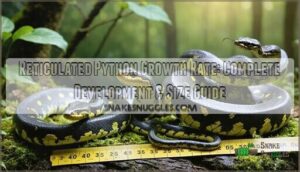This site is supported by our readers. We may earn a commission, at no cost to you, if you purchase through links.

Hatchlings start small, around 18 inches, but with steady meals and the right conditions, they can top 15 feet by age three.
Females usually outpace males in size, and if you’re eyeing a more manageable pet, dwarf and super dwarf morphs rarely exceed 8-12 feet.
Consistent feeding, warmth, and space are your keys to a healthy giant.
Curious about their record-breaking sizes and care secrets?
Table Of Contents
- Key Takeaways
- Reticulated Python Growth
- Factors Affecting Growth Rate
- Growth Patterns and Stages
- Size Variations and Records
- Health Considerations and Care
- Longevity and Reproduction
- Frequently Asked Questions (FAQs)
- How fast do reticulated pythons grow?
- What is the lifespan of reticulated pythons?
- How big do reticulated pythons get?
- Why are reticulated pythons so big?
- What does a reticulated python look like?
- How long is a 2 year old reticulated python?
- Can pythons grow to 20 feet?
- What is the growth rate of a python?
- What is the largest confirmed reticulated python?
- Do reticulated pythons grow faster in summer?
- Conclusion
Key Takeaways
- You’ll see explosive growth in the first three years – Your reticulated python can add 5-6 feet annually during this period, growing from an 18-inch hatchling to potentially 15+ feet by age three.
- Females grow larger than males consistently – You can expect female reticulated pythons to reach 16-23 feet on average, while males typically stay between 10-14 feet throughout their lives.
- Growth continues throughout their entire lifespan – Your python won’t stop growing after maturity like mammals do, though the rate slows dramatically to just inches per year after age three.
- You control their growth through care conditions – Consistent temperatures (78-88°F), proper humidity (50-60%), adequate space, and regular feeding directly impact how fast and large your python grows.
Reticulated Python Growth
Understanding your reticulated python’s growth patterns starts with recognizing the three key factors that shape their development: genetics, environment, and nutrition.
These massive constrictors can reach impressive lengths of 20+ feet, but their growth rate depends heavily on how well you manage their care requirements and feeding schedule.
Genetic Factors Influence
Your reticulated python’s genetic blueprint determines its ultimate size potential through heredity traits passed from parent to offspring.
Your python’s DNA blueprint sets the growth ceiling before you even bring it home.
DNA influence controls growth hormones, metabolic rates, and maximum length capabilities.
Genetic diversity among populations creates inheritance patterns that produce everything from massive 30-foot giants to compact dwarf morphs, which are influenced by genetic factors.
These genetic factors basically set your snake’s "growth ceiling" before you even bring it home.
Environmental Impact
Environmental factors substantially influence your reticulated python’s growth trajectory.
Temperature gradients between 78-88°F optimize metabolic efficiency, while humidity levels of 50-60% support proper shedding cycles.
Adequate lighting cycles regulate circadian rhythms, affecting feeding responses.
However, habitat loss and invasive species in wild populations impact natural growth patterns.
Conservation efforts through CITES trade regulation help protect these magnificent serpents from environmental pressures that could stunt development.
Nutrition and Size
Your python’s nutritional intake directly determines its reticulated python growth rate.
Feeding frequency should match age – juveniles need weekly meals while adults eat every 2-3 weeks.
Prey size matters: offer items 10-15% of your snake’s body weight.
A balanced diet prevents obesity risks that plague captive pythons.
Monitor python size variation carefully, as overfeeding accelerates growth unnaturally.
Proper python diet management eliminates supplement needs in healthy specimens.
Factors Affecting Growth Rate
Your reticulated python’s growth rate depends on several key environmental factors you can control.
Temperature, humidity, lighting, and enclosure size work together to create conditions that either support or limit your python’s development potential.
Temperature and Humidity
When temperature and humidity align perfectly, your reticulated python’s growth rate accelerates dramatically.
Maintain basking spots at 88-92°F with ambient temperatures around 76-82°F for ideal thermal regulation.
Keep humidity levels between 65-85% through proper moisture management and environmental control.
Digital thermostats and heat sources guarantee consistent conditions, while proper snake enclosure humidity prevents stunted development.
To achieve prime growth, it’s vital to understand humidity management techniques and their impact on your snake’s environment, ensuring optimal environmental control.
Lighting and UVB Needs
You’ll release your python’s full potential when proper lighting mimics their natural habitat.
While UVB lighting isn’t essential for reticulated python growth, establishing consistent photoperiod cycles with appropriate basking lights optimizes their metabolic processes and supports healthy development.
Consider these lighting essentials for ideal python habitat setup:
- 12-hour photoperiod cycles maintain natural circadian rhythms
- 6500K color temperature bulbs replicate daylight conditions
- Ceramic heat emitters provide nighttime warmth without disrupting sleep
- Timer-controlled lighting cycles guarantee consistency for stress reduction
- Avoid constant illumination which can suppress natural behaviors
Proper lighting cycles directly influence your reticulated python growth rate by regulating feeding responses and activity patterns.
Quality reptile growth rate depends on environmental stability, making consistent photoperiod management essential for your python enclosure setup success.
Understanding UVB lighting needs is vital for creating a healthy environment that promotes ideal growth and development in reticulated pythons.
Enclosure Size Importance
Your python’s habitat size directly impacts its growth rate and overall health.
Adequate space requirements allow for proper snake movement, which promotes muscle development and prevents stress-related growth stunting.
Enclosure depth should accommodate the python’s full length when stretched, and proper ventilation systems maintain air quality.
While habitat design encourages natural behaviors essential for healthy development in your reticulated python, providing the right python enclosures is essential for creating a suitable environment that supports the snake’s overall well-being with a proper environment.
Growth Patterns and Stages
Understanding reticulated python growth patterns helps you predict your snake’s development and plan appropriate care. These massive constrictors follow distinct growth stages, from explosive early development to steady lifelong expansion.
Rapid Growth Phase
Young reticulated pythons are teenage growth machines, experiencing explosive juvenile development during their first three years.
These powerful serpents explode from hatchlings to giants in just three years.
Your python’s reticulated python growth rate peaks dramatically as growth hormones surge through their system. Size genetics determine potential, but feeding strategies maximize these incredible growth spurts.
Key Rapid Growth Phase Characteristics:
- First-year explosion – Hatchlings grow from 2 feet to potentially 8-10 feet
- Annual gains – Adding 5-6 feet per year during peak periods
- Metabolic intensity – High-energy systems driving continuous expansion
- Feeding frequency – Requiring regular meals to fuel growth rate influencers
- Environmental optimization – Warm temperatures accelerating cellular development
This python growth chart shows remarkable consistency across healthy specimens during their explosive early years.
Slowed Growth After Maturity
After reaching sexual maturity around three years, your reticulated python’s growth rate dramatically shifts from breakneck speed to a leisurely crawl.
Growth plateaus become the new normal as your snake’s body focuses on adult maintenance rather than rapid expansion.
Post maturity, these serpents add only inches annually instead of feet, though slowdown factors like genetics and feeding still influence their python growth stages throughout their extended lifespan.
Indeterminate Growth Explained
Unlike mammals, you’ll find reticulated pythons possess indeterminate growth – they continue growing throughout their entire lifespan.
Growth hormones and cellular regeneration maintain tissue expansion even after sexual maturity, though metabolic rates slow considerably.
This developmental pattern means your python’s growth potential remains active across all life stages.
Reticulated pythons exhibit characteristics of animal growth patterns similar to other species with indeterminate growth.
- Growth hormones remain active throughout the python’s entire lifespan, enabling continuous size increases
- Cellular regeneration allows tissue expansion and vertebrae addition even in mature adults
- Metabolic rates decrease with age but never completely halt the growth process
- Developmental stages don’t include a terminal growth phase like mammals experience
- Python growth potential theoretically continues indefinitely under ideal conditions
Size Variations and Records
Understanding size variations in reticulated pythons helps you set realistic expectations for your snake’s potential.
These impressive reptiles show remarkable size differences based on genetics, with records spanning from compact dwarf morphs to massive specimens exceeding 30 feet, which is a key factor in determining the size of your snake.
Average Adult Length
Adult reticulated pythons typically reach 16-23 feet in length, with significant size factors creating notable length variations between sexes.
Males average 10-14 feet while females exceed 16 feet, showcasing clear adult dimensions differences.
These growth limits reflect natural snake morphology patterns, where reticulated python growth continues throughout life but slows considerably after maturity.
Understanding python growth rate helps predict final size through various snake growth stages and enables accurate python size comparison assessments, which is crucial for understanding the growth stages.
Largest Recorded Pythons
Beyond the average adult measurements, reticulated pythons produce true Record Breakers that showcase the species’ ultimate size potential.
These Giant Snakes represent the pinnacle of Python Length achievement:
- Medusa holds the captive record at 25.2 feet and 350 pounds in Kansas City
- The controversial 1912 Sulawesi specimen claimed 32.9 feet but lacks modern verification
- Fluffy reached 24 feet at Columbus Zoo before her death in 2010
These Massive Specimens demonstrate how ideal conditions can produce recordbreaking Largest Caught individuals.
The study of largest snake species helps researchers understand the factors contributing to exceptional growth in these animals.
Dwarf and Super Dwarf Morphs
Dwarf genetics revolutionize reticulated python growth expectations, with Super Dwarf morphs reaching just 6-7 feet compared to mainland giants.
These miniature breeding programs produce stunning color variations while maintaining manageable sizes.
Python size variation depends on locality percentages – higher Super Dwarf lineage means smaller adults.
Dwarf reticulated pythons offer the species’ beauty without overwhelming space requirements, making python growth rate predictable for keepers, which is a result of Super Dwarf lineage.
Health Considerations and Care
Proper feeding practices prevent obesity-related health issues like respiratory problems, heart disease, and liver complications that commonly affect captive reticulated pythons.
Adequate enclosure space allows essential movement and exercise, preventing spinal deformities and weakened immune systems associated with stunted growth in confined environments, which is a complete concept related to the health of reticulated pythons, and essential movement is crucial for their well-being.
Importance of Proper Feeding
You’ll find that feeding strategies directly impact your python’s growth trajectory and overall health.
Proper nutrition balance involves offering appropriately-sized prey items every 2-3 weeks for adults, with food quality being paramount—frozen-thawed rodents provide consistent nutrition while supporting digestive health.
Your python’s metabolic rate increases with regular feeding schedules, making diet management a key python growth rate influencer in your python care guide.
Understanding frozen rodent sources, such as reliable food suppliers, is essential for maintaining a consistent diet.
Enclosure Size and Exercise
Your reticulated python’s cage-size requirements directly impact their movement patterns and overall health. Inadequate space causes stress, stunted growth, and spinal deformities in these magnificent serpents.
Essential enclosure requirements include:
- Minimum floor space: 8×4 feet for adults under 16 feet
- Height clearance: 3-4 feet for vertical movement and thermoregulation
- Length proportions: Enclosure should equal 50% of snake’s total length
- Exercise zones: Multiple levels and hiding spots for natural behaviors
- Expansion planning: Upgrade housing as your python grows throughout life
Proper enclosure size considerations, such as optimal space needs, are vital for preventing health issues in snakes.
Longevity and Reproduction
Understanding your reticulated python’s lifespan and reproductive patterns helps you plan for long-term care commitments and breeding considerations.
These remarkable serpents can live 15-30 years in captivity, with females producing substantial clutches of 25-50 eggs after reaching sexual maturity around 2-3 years of age, which is crucial for breeding considerations.
Average Lifespan in Captivity
With proper care, you’ll find captive reticulated pythons typically live 15-22 years, with exceptional individuals reaching 32 years.
Their aging process depends heavily on habitat quality, veterinary needs, and consistent python care.
Captive longevity substantially exceeds wild lifespans due to controlled environments and regular health monitoring in captive breeding programs.
| Age Range | Life Stage | Care Requirements |
|---|---|---|
| 0-3 years | Juvenile Growth | Frequent feeding, temperature control |
| 4-10 years | Prime Adult | Regular health checks, stable habitat |
| 11-20 years | Mature Adult | Reduced feeding, joint care |
| 21-25 years | Senior | Specialized veterinary monitoring |
| 26+ years | Exceptional |
Intensive supportive care.
The table outlines the life stages of captive reticulated pythons, including juvenile growth, prime adult, mature adult, senior, and exceptional stages, each with distinct care requirements for optimal health and longevity.
Wild Lifespan and Differences
Wildlife’s harsh realities dramatically impact python lifespan in the wild, where survival rates plummet compared to captivity.
Environmental pressures like predation, disease, and food scarcity create significant mortality factors that reduce python lifespan to approximately 15-20 years.
Geographic variance across wild habitat regions affects reticulated python growth rate differently, with wildcaught specimens showing stunted development patterns compared to their captive counterparts, due to the harsh realities of the wild.
Reproductive Habits and Egg Laying
Throughout their impressive breeding seasons, female reticulated pythons display remarkable reproductive habits that showcase nature’s adaptability.
These powerful constrictors demonstrate sophisticated behaviors from courtship through hatchling independence.
Here’s what makes their reproductive cycle fascinating:
- Egg Incubation – Females maintain precise temperature control through shivering thermogenesis during 70-88 day incubation periods
- Clutch Size – Ranges from 8-107 eggs, with larger females producing substantially more offspring
- Female Guarding – Mothers coil protectively around eggs, fasting completely during incubation without abandoning their post
- Hatchling Care – Newborns emerge fully independent, immediately hunting small prey without parental assistance
In contrast to some species, like boa constrictors that exhibit ovoviviparous traits, reticulated pythons lay eggs externally, relying on environmental conditions for successful hatching.
Frequently Asked Questions (FAQs)
How fast do reticulated pythons grow?
Like a rocket accelerating through space, reticulated pythons (Malayopython reticulatus) experience explosive growth during their first three years, adding 5-6 feet annually before adult growth patterns stabilize around maturity.
What is the lifespan of reticulated pythons?
Reticulated pythons typically live 15-20 years in captivity, with some reaching up to 32 years. Wild individuals usually have shorter lifespans due to environmental pressures and predation risks.
How big do reticulated pythons get?
You’ll find these impressive constrictors reaching average lengths of 16-23 feet, with exceptional females exceeding 30 feet. Most adults range 10-20 feet, though record specimens hit 32-33 feet long.
Why are reticulated pythons so big?
Massive metabolic machinery makes reticulated pythons remarkably robust reptiles.
You’re witnessing evolutionary excellence – their indeterminate growth pattern means they never stop growing throughout their 20-30 year lifespan, unlike mammals that reach fixed adult sizes, which showcases their remarkably robust nature.
What does a reticulated python look like?
You’ll recognize a reticulated python by its distinctive diamond-shaped blotches bordered with black and yellow, creating a net-like pattern.
Their ground color ranges from blue-gray to brown, with iridescent scales that shimmer in sunlight.
How long is a 2 year old reticulated python?
Looking at Malayopython reticulatus growth patterns, by two years old, you’ll typically see these pythons reaching 12-15 feet in length.
Having experienced their most explosive growth phase during their first three years of life, this period is crucial for their development, with the first three years being the most significant.
Can pythons grow to 20 feet?
Yes, reticulated pythons can absolutely grow to 20 feet. They’re among the world’s longest snakes, with exceptional females reaching over 20 feet and weighing 250+ pounds under ideal conditions.
What is the growth rate of a python?
You’ll see explosive growth in reticulated pythons during their first three years, adding 5-6 feet annually. Growth then slows markedly after reaching maturity around age three.
What is the largest confirmed reticulated python?
The largest confirmed reticulated python reached an absolutely mind-blowing 32-33 feet in length, recorded in Indonesia back in
This massive Malayopython reticulatus specimen weighed approximately 400 pounds, making it the longest snake on record, and it is a truly massive example of its kind.
Do reticulated pythons grow faster in summer?
Temperature fluctuations don’t substantially impact reticulated python growth rates. You’ll find their growth depends more on consistent warmth, humidity, and food availability rather than seasonal temperature changes affecting their metabolism.
Conclusion
Like a river’s steady flow shaping the landscape, reticulated python growth rate follows predictable patterns you can track and influence.
You’ll find these serpents reach impressive lengths through consistent care—proper temperatures, adequate space, and regular feeding schedules.
Whether you’re raising a standard reticulated python or a dwarf morph, understanding their growth requirements helps you provide ideal conditions.
Monitor their development, adjust care as needed, and you’ll witness one of nature’s most remarkable transformations unfold in your own setup.
- https://animals.mom.com/fast-reticulated-pythons-grow-10421.html
- https://animaldiversity.org/accounts/Python_reticulatus/
- https://hellcreekreptiles.com/care-sheets-and-articles/f/a-brief-guide-to-understanding-and-keeping-super-dwarf-retics
- https://www.petmd.com/reptile/species/reticulated-python
- https://legaseaaquarium.com/pages/daisy-albino-reticulated-python















